Wisconsin Center Will Destroy Literary Artworks
Nationally unique installation done in 1998. Public board didn't vote on its destruction.
The Wisconsin Center District plans to destroy a literary arts installation created in 1998, featuring quotes from famous Wisconsin writers like Laura Ingalls Wilder, Zona Gale, Aldo Leopold, Edna Ferber, John Muir, Lorine Niedecker and more contemporary names like Antler and Martha Bergland.
The installation was created after a request for proposals by the Milwaukee Arts Board sought unique artworks for the building.
“The installation had tremendous public support,” says sculptor Jill Sebastian, who served as the artist who designed and installed the work. “Mayor John Norquist was a big supporter.”
The project took three years to create, recalls Karl Gartung, former artistic director for nonprofit book store and arts center Woodland Pattern, and involved at least a year of work by a committee of seven people to find and choose work by Wisconsin writers to feature.
The installation includes texts by 48 different writers going back 400 years, including lyrics from an Ojibe Tribe song.
“It is a live, on-the-wall anthology that is not duplicated anywhere in the country, as far as we know, where writing is treated as being just as important as any other art form,” Gartung says.
Because the work was permanently installed, it cannot be removed in any way that will preserve it. The work will be destroyed in the process of removing it. Sources say work to destroy the installation will begin tomorrow.
“It seems like an act of cultural vandalism,” Gartung says.
Alderman Bob Bauman, who serves on the Wisconsin Center District Board, and in whose district the convention center is located, says the decision to remove the installation was never cleared with the board.
“There has been no discussion,” Bauman says. “It has never been reported to the board or debated or voted on.”
The 17-member board of directors includes 17 public officials, most of them elected officials, including three Milwaukee Common Council members (Bauman, Milele Coggs and council president José G. Pérez), two legislators from Milwaukee (Sen LaTonya Johnson and Rep. Kalan Haywood), the city and county comptrollers (Aycha Sawa and Scott Manske), Senate Majority Leader Devin LeMahieu and Wauwatosa Mayor Dennis McBride. The private board members include Greg Marcus, whose father Steve Marcus created the Sculpture Milwaukee exhibition and whose company, the Marcus Corp., runs Saint Kate The Arts Hotel.
Laura Solomon and Jenny Gropp, who serve as the current co-executive directors of Woodland Pattern, told Urban Milwaukee that they were informed in January that the works would be taken down and the contract for the creation of the 1998 installation included no protection against deaccessioning or taking down the work. A lawyer for Woodland Pattern reviewed the contract and verified that this was the case. Solomon and Gropp then met with Wisconsin Center officials who agreed to provide a $20,000 grant to Woodland Pattern to create a hardcover book with photos and text to memorialize the installation project. “We are grateful that they offered us funds for the book,” Solomon said.
Sources told Urban Milwaukee that the decision to remove the works was made by Marty Brooks, CEO for the Wisconsin Center, and that the development team involved in the center’s expansion project did not know what the reasons for this were.
“Marty Brooks believes he has considerable authority as the chief executive officer,” Bauman says. “He was very perturbed when there was pushback from the board on the contract with the Pabst to manage the Miller High Life Theater.” Board members insisted on a vote, he recalls, and approved the decision whereby the Pabst books all concerts for the theater.
Urban Milwaukee contacted both Brooks and the Wisconsin Center’s media representative Sarah Maio and has not heard back from them. Urban Milwaukee also reached out to many public officials from the board seeking comment. This story will be updated as we hear more.
Update 4:00 p.m. April 4: Wisconsin Center media presentative Sarah Maio called Urban Milwaukee and confirmed that the board of directors was not consulted about the decision to take down the installation and said that the board’s approval of the 2020 resolution to approve expansion “authorized the CEO to manage and mitigate every decision and challenge” of the expansion. When asked who had the idea to take down the installation Maio said she couldn’t say, but said “all decisions were made by the CEO and the project management team.” When asked if the Wisconsin Center made any attempt to get public feedback or response to the decision to take down a 25-year-old public art installation, Maio said no. Finally she said the removal of the installation will begin on April 10, but prep work will begin on Wednesday, April 5.
Photos
If you think stories like this are important, become a member of Urban Milwaukee and help support real, independent journalism. Plus you get some cool added benefits.
More about the Wisconsin Center District Literary Arts Installation Controversy
- ‘Polka Time!’ Escalator Gets Celebratory Sendoff - Sophie Bolich - Aug 18th, 2023
- Wisconsin Center Makes Deal to Save Literary Artwork - Bruce Murphy - May 1st, 2023
- Back in the News: Wisconsin Center Dispute Goes National - Bruce Murphy - Apr 25th, 2023
- Murphy’s Law: Did Brooks Exceed His Authority At Wisconsin Center? - Bruce Murphy - Apr 18th, 2023
- Wisconsin Center Pauses Art Removal - Jeramey Jannene - Apr 14th, 2023
- Revised Letter to Wisconsin Center District CEO Marty Brooks - Press Release - Apr 11th, 2023
- Back in the News: Wisconsin Center Accused of Censorship - Bruce Murphy - Apr 11th, 2023
- Back in the News: Wisconsin Center Won’t Reconsider Removing Literary Artwork - Bruce Murphy - Apr 5th, 2023
- Murphy’s Law: Wisconsin Center Will Destroy Literary Artworks - Bruce Murphy - Apr 4th, 2023
Read more about Wisconsin Center District Literary Arts Installation Controversy here
Political Contributions Tracker
Displaying political contributions between people mentioned in this story. Learn more.
Murphy's Law
-
National Media Discovers Mayor Johnson
 Jul 16th, 2024 by Bruce Murphy
Jul 16th, 2024 by Bruce Murphy
-
Milwaukee Arts Groups in Big Trouble
 Jul 10th, 2024 by Bruce Murphy
Jul 10th, 2024 by Bruce Murphy
-
The Plague of Rising Health Care Costs
 Jul 8th, 2024 by Bruce Murphy
Jul 8th, 2024 by Bruce Murphy


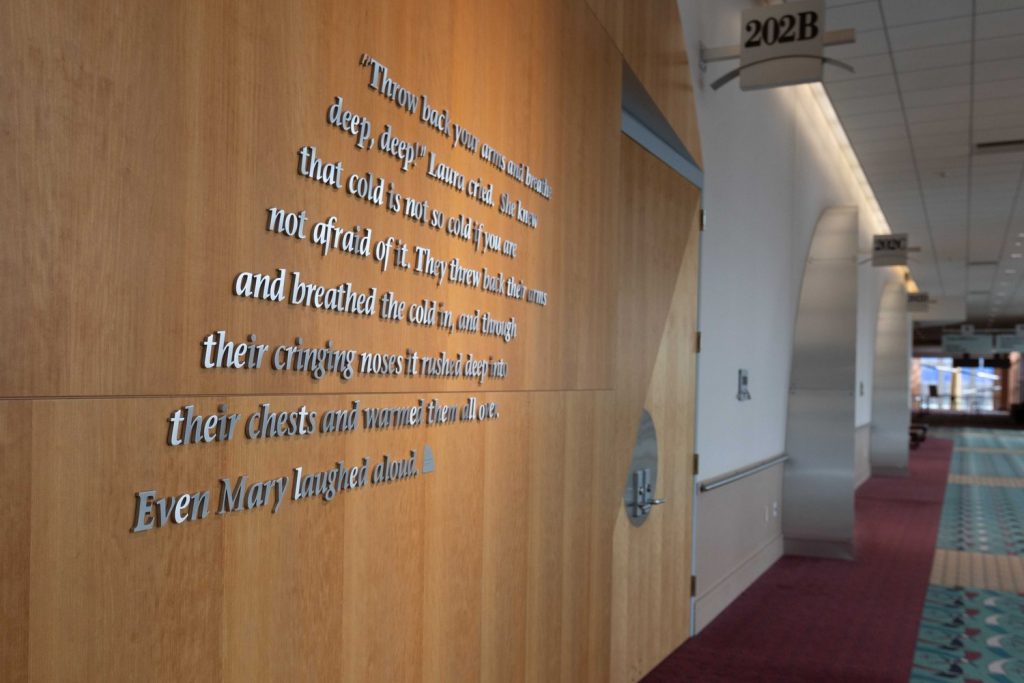
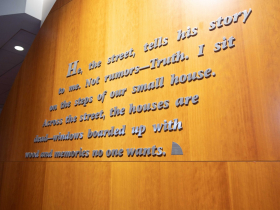
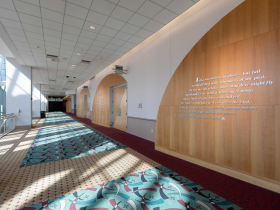

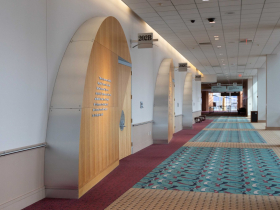
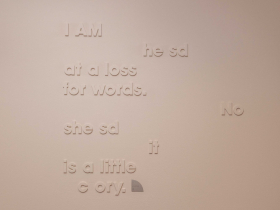
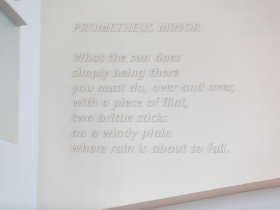

















It’s a shame that it must be destroyed because it was permanently installed. Good note for future installations. That said, I’m sure there is some way to salvage some elements and recreate it.
It’s interesting that there is no mention of an artist or artists It “was created,” passively. I’m stretched to remember a single work of art I have viewed or am otherwise familiar with that isn’t the result of one or more artists being inspired, going through a process of sketches, drafts, miniatures, etc. until a final work is created. Who is the artist(s) whose inspiration informed the shape, materials, texture, size, font size, etc. for this “work of art.”
Is it really art if there is no artist, or is it simply an installation or design element?
Polaris, sculptor Jill Sebastian was the artist “whose inspiration informed the shape, materials, texture, size, font size, etc.” for this installation.
This seems to be a shame.
Always really liked these.
The words bore additional resonance considering personal experiences going to the center in 2021 for mass vaccination.
Jill, your work has/had meaning (as do/did the words of the authors and cultural figures represented through them).
Sad that there does not seem a good explanation for why there is a benefit to their removal.
I wonder what Baird leadership will think.
Oh, for cripes sake, Bruce…thanks for clarifying! I didn’t see this the first 3-4 times I went through the article. Chalking it up to old age…! 😉
I’ve sent this message to Mr. Marty Brooks’s email address on the Wisconsin Center website:
Mr. Brooks,
We hope your motto is not “Move fast and break things.” If Bruce Murphy’s article today is correct, you are making a mistake by destroying one of the few memorable parts of the Wisconsin Center. Please pause and re-think this problem.
Sincerely,
Larry Hoffman, Ph.D.
“You can’t be neutral on a moving train.” — Howard Zinn
Among the many segments in this installation, there is a strong emphasis on Wisconsin’s Indigenous history and experiences. That is an important cultural legacy with rather scant recognition in public places in Milwaukee.
With that in mind, what will be lost, for residents and visitors, through this planned erasure?
🥺
A lot of time, talent, effort and money went
into this project. How about an encore?
Was this project made with any mandated funds
for art in public buildings? If so, taxpayers may own
this work. Can the authority to alter or destroy it
be legally given to one individual?
Maybe the new design cannot reasonably accommodate
this work, but it’s wrong to to dismiss and destroy it.
How much of it actually needs to be destroyed?
Were any elements pre-built, but installed in a way
that conceals this fact. Have any of the installers been
contacted about this aspect?
It looks like a good number of the largest works
are on casework built separately from and added to the walls.
I’ve done a few similar but much smaller installations, and the 1st thing
I would check is whether the casework can be removed from the wall,
(even if not intact) and in a way that usable areas of the
front panels can be removed intact.
These panels would eventually need to be cut to a shape
compatible with a new environment.
At least one photo shows a panel that can be taken off
by removing 4 fasteners.
Works that are on non–bearing walls might be retrieved
by cutting a section out of the wall. This section might be
reused, or disassembled leaving the front panel intact.
This panel may be weak once separated, so that operation
may need to be done at the new site.
Where nothing else can be done, at least
remove and save the (labor intensive) letters intact.
Everything I’ve suggested should be weighed by
cost/benefit comparison to re-creating the works.
Marty asks important questions. Will anyone ask them in a public forum?
All indicators point to the Wisconsin Center no longer functioning as a public space, if one man (and perhaps his coterie) make all decisions about every aspect of that space, including the casual destruction of publicly funded art.
No one has mentioned what taxpayer-funded “art” or decoration will replace this thoughtfully conceived installation created WITH public oversight.. Apparently it’s none of the public’s business.
The funding program I was thinking of was called
Percent for(the?) Arts. I don’t know if it still exists,
or what legal requirements were attached
to funds that they disbursed.
“The Public Artworks of Wisconsin is an interactive map
highlighting more than 130 art installations commissioned
through the state’s Percent for Art Program.”
The Wisconsin Center is included on the interactive map,
but this does not state which artworks were funded at this location.
Given the demolition timing, a court order to stop may be needed to allow time to check the legalities, unless all options have already been exhausted.
Great insight into a very disturbing news item. If, in fact, any part of this incredible installation can be saved without blowing the budget, it must be. If it’s not feasible to save, then we must find a way and place and money to recreate it somewhere else in the city. It is too important to simply let it go! Maybe for one of our downtown area or lakefront parks? The MAM or new MPM grounds? Couture or Vel Phillips plazas? Murals? Third Ward streetscape? Under the 794 freeway? Let’s spread the word and at least try to make this happen. Certainly a private/public partnership could keep this valuable piece of our heritage from going away.
If nothing else, they should allow a good local art photographer a chance to fully document the present installation in high quality photos that can then be installed as “art of art”. I can understand the desire to take it down, possibly replace it with something “newer”, but to simply remove and forget is wrong. Sometimes the best art is that which is found decades later tucked in a closet or warehouse, ready to be enjoyed by a new generation.
As always, there is nothing more incendiary, controversial or enlightening than public art and Milwaukee has had its share.
Perhaps the new convention center can bring back The Blue Shirt.
While reading lobk’s ideas, I realized that this
exhibit was doomed by its location. It’s big, and the
Wisconsin Center is big, but who other than the
Center’s employees can take it all in?
Conventioneers’ days are full. When each day’s business
closes, so does the center. Tour guide materials and
promotions are going to direct them (as well as Milwaukee
residents) to other attractions.
As iobk suggests, it needs to be more conspicuous
and accessible. However, these works were not
built for outdoor exposure The Grand Ave. Mall and our
skywalk system may have the lineal feet needed,
but does it have enough good places to
accommodate such a large body of works?
Being indoors, it would provide all-weather and
all season access.
Anywhere else? …before it’s all destroyed?
@blurondo…OMG–Blue Shirt!
Seriously, I actually liked it, conceptually speaking. It was big, colorful, translucent. My only real question was: “It’s the airport, why a blue shirt?”
Seemed like, in the lack of context, some Milwaukeeans created their own, i.e., that the artist (whose inspiration informed the shape, materials, texture, size, etc.” of the proposed installation) was condescending to the city’s blue collar history. Frankly, if you gotta dig that deep, you’ve probably got a chip on your shoulder about your blue collar history… 🙂
@Marty Ellenbecker — Agreed. Such a great concept, why hide it on the second floor where only busy conventioneers will experience it as they hustle between meeting rooms? In whatever future form this might take, it deserves a more public venue.
In a way, this reminds me of one of the more contemplative human-made spaces in San Francisco, the Martin Luther King Jr. Memorial.
https://youtu.be/J8GA_iAEvpQ
That its home is the wonderful Yerba Buena Gardens and it is available 24/7 is a huge bonus.
Good conversations on this wonderful piece of art that needs to be saved or recycled.
If memory serves, there are other interesting pieces of art throughout the Convention Center. Will they be destroyed as well as the renovation work continues?
I believe it was the Burke Family Foundation that underwrote much of the public art in the current building. The 1% for Art program for new building projects in the City of Milwaukee had success during the 1990”s but we hear nothing of it these days. What happened?
Marty, in response to your question …”but who other than the
Center’s employees can take it all in?” The works are individually accessible and inviting, As with Lake Michigan, or any expansive vista, there is rhythm and flow and no need to take it all at once. Part of its beauty and power is its elegance and grace.
This work, these words, this history also humanizes and grounds an otherwise mostly generic space. That was intended by the makers and the dedicated arts board that oversaw the process of its creation.
The other big question here is: What has one man decided to replace as the storytelling and imagery within the Wisconsin Center District?
Lord Acton warned about the inevitable corrupting results of granting anyone absolute power. A publicly funded and owned space is not the same as one’s sovereign home or even a corporate headquarters. Public art is not wallpaper, nor is a convention center a corporate campus or private sandbox.
Calling someone a CEO does not change the fact that taxpayers are the actual funders and owners of this space. Representative bodies must represent and oversee the people’s interests, the community’s interests.
We will have no public spaces, no places of belonging for all, if all decisions about them, and about our civic culture, are made unilaterally, especially by a single person. Milwaukee will increasingly become an impoverished place within its public spaces, which should be alive, inclusive and reflective of the greatness of our city.
I went to a couple of conventions at the center and I always looked forward to finding the quotes that moved me. It was also nice to decompress between sessions, sit there in the space and read the lines and wonder about the meanings and why that quote was picked above others. It was a lovely feeling to be literally surrounded by beautiful prose and poetry. It is really disheartening to read that the decision was made by a single person without the consideration of others– but that seems to be the trend these days.